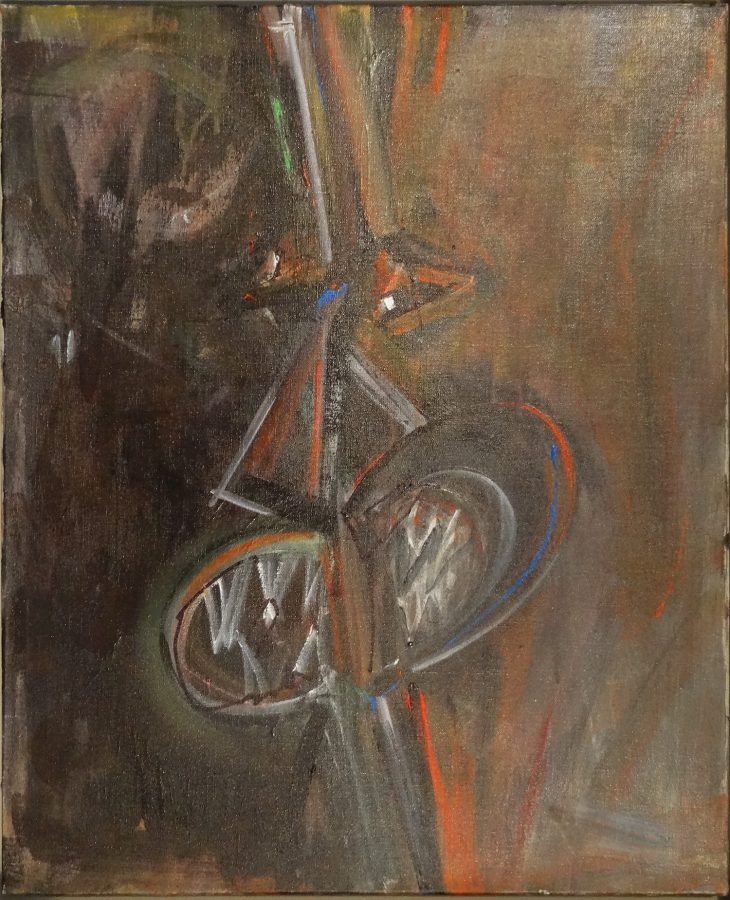Merton D. Simpson (1928 – 2013)
Confrontation, 1974
Oil on Canvas
24 ⅛ x 19 ⅝ in. (61.28 x 49.85 cm)
Merton D. Simpson was an Abstract Expressionist painter who worked throughout the second half of the twentieth century, in addition to his renowned work as a collector and dealer of African art. He was born in 1928 in Charleston, South Carolina, one of eight children. For years of his childhood, he was in the hospital with diptheria and rheumatic fever. This kept him out of school until the fifth grade, but while in the hospital he took to drawing from a very young age. The local artist William Halsey recognized his skill and began instructing a teenage Simpson in drawing and painting, although, because of the prejudicial laws of the time, he was not allowed to attend classes at the public Gibbes Gallery where Halsey worked.
As Simpson emerged as an artist in segregated Charleston, prejudice continued to constitute an obstacle to his professional exposure, though he remained steadfast to his craft. Almost as soon as he graduated from high school, Simpson had a solo exhibition at the Gibbes Gallery. Concerning its opening, Simpson commented: “Laura Bragg, who was the moneyed woman in Charleston, said if you want to have a show for Simpson we’ll have a show and if you want to have a show with two openings we’ll have a show with two openings, one for Blacks and one for whites and if you want to have a third one for Blacks and whites who want to be together, but you’re gonna have it” (1).
Simpson moved to New York in 1949. There, he attended both Cooper Union and New York University, where he took classes taught by the likes of Hale Woodruff and Robert Motherwell, while also working at a frame shop that was frequented by artists such as Max Weber, Hans Hoffmann, and Willem de Kooning.
Simpson enlisted in the Air Force in 1951 and was assigned as an official Air Force artist to travel around the country and paint portraits of generals on commission. During this period, his work gained acclaim in New York, appearing in exhibitions at the Metropolitan Museum of Art, the Museum of Modern Art, and the Guggenheim. After his time in the service, Simpson traveled to Europe in order to see African sculptures in European museums and collections. He noted the modernist interest in African sculpture, but wanted a deeper knowledge: “I was so taken with them, with the forms, you know — people talked about Picasso, Miro, and I used to say, ‘What about African sculpture,’ which these people sort of got this idea from. But they would never say sculpture, they would always say the Picasso, the Miro, the this, and the that, without getting to the source of this whole bit” (2).
In the 1950s Simpson divided his time between Paris and New York, collecting art and performing as an amateur jazz musician. In 1954 he opened the Merton D. Simpson Gallery of Modern and Tribal Arts, where he exhibited indigenous African works alongside works by his contemporaries. He amassed a significant collection of historical indigenous African works, including Benin, Dogon, Dan, Lega, and Luba works. Simpson also used materials derived from indigenous African crafts in his own work, such as the Mali hunting clothes used in some of his works from the early 1990s.
Simpson was a member of Spiral, a group founded in 1963 by Romare Bearden, Charles Alston, Hale Woodruff, and Norman Lewis, in order to promote the work of Black artists and emphasize work that responded to the Civil Rights Movement. One significant example of this is Simpson’s Confrontations from the 1960s, which responded to the racial tensions of the time period and in particular the Harlem Riot of 1964. Concerning the series, Simpson says: “I’m deeply involved now in this business of black-white confrontation, the problem of the two American most contrasting segments, I mean the black-white bit, fighting each other, almost sort of killing each other off; not yet, but certainly coming to this” (3).
Simpson’s Confrontation (1974) does seem to depict a life-or-death situation: two faces, one Black and one white, are shown in profile pressed flat against one another, while also yielding to a reading as one face shown straight-on. The intense antagonism pictured here reflects the violently racist cultural climate to which Simpson was responding. Both wear expressions of anger, and the palpable tension between the two seems untenable. These faces, the only instances of figuration in this work, are discernable primarily by their narrowed eyes and bared teeth, outlined and highlighted with orange, white, and blue brushstrokes. Their respective skin colors are blended directly on the canvas, making the image vibrate with tension.
According to Bill Hodges, “[Simpson’s Confrontation paintings] are all highly charged and very meaningful for me; for the type of work I do, and the challenges I and I’m sure many of our people face every day . . . but I am especially taken to them because of my challenges to get great works composed by the artists who laid the foundation . . . the Black artist and the so-called negro artist of fifty, sixty, and seventy years ago, when the museums knew great work was being created and ignored it” (4).
Simpson, a painter, collector, dealer, and musician, was a good friend of Bill Hodges and died in 2013.


